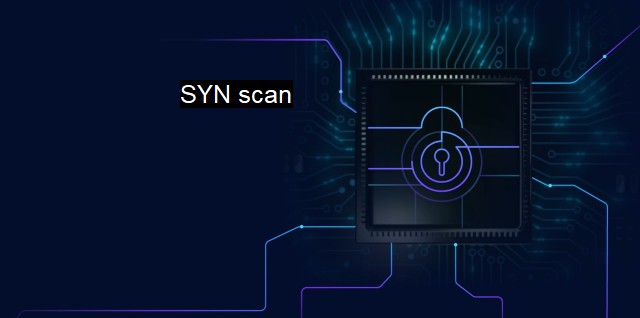What is SYN scan?
Exploring SYN Scans: A Common Attack Vector in Cybersecurity and its Procedures
In the realm of cybersecurity and antivirus protection, understanding different types of network scanning techniques is vital. One such technique prevalently used by both ethical and malicious hackers is the SYN scanning. Also known as half-open scanning or stealth scanning, SYN scan is a method used to identify open ports which could then be exploited on a targeted system.This network intrusion detection protocol exploits the three-way handshake process intrinsic in a Transmission Control Protocol (TCP) connection, the primary protocol in establishing internet connections. Normally, the client sends a SYN packet (Synchronize sequence numbers) to initiate a connection followed by the server acknowledging the request with a SYN/ACK packet (Synchronize-Acknowledgment). Then, the client finishes the handshake by responding with an ACK (Acknowledgment) packet. At the end of this process, a connection is established and the port is deemed ‘open’.
SYN scanning deviates from this typical connection procedure to remain undetected. An attacker sends initial SYN requests to diverse ports on a targeted server, effectively masking their Internet Protocol (IP) address. The host machine, acting routinely, responds with SYN/ACK packets, assuming the request for communication is valid. But instead of finalizing the handshake with an ACK response (thereby fully opening a connection), the attacker either sends a RST (Reset) command to terminate the premature connection or doesn't respond at all, hence the term "half-open scanning".
The primary goal of a SYN scan is to expose open ports rather than establishing a connection. Because no connection is made at all, the process is substantially harder to detect and hence referred to as ‘stealth’ scanning. Typically, only advanced intrusion detection systems can identify half-open connections and flag them as potential threats against network security.
The implications of a SYN scan can vary from harmless to potentially hazardous, depending on the intent. From a securities perspective, ethical hackers, also known as white-hat hackers, use SYN scan for benign purposes like analyzing networks for vulnerabilities that can be patched before they are exposed to potential threats. Administrators and cybersecurity professionals perform SYN scans as part of routine audits and threat assessment to fortify the security system.
On the other hand, when performed by malicious hackers or black-hat hackers, SYN scan provides a reconnaissance method for identifying open ports to launch attack vectors. Information collected from these scans is used to infiltrate systems or networks, deploy malware, or perform Denial of Service (DoS) attacks.
In a DoS attack, SYN scan is employed through a SYN flood, essentially overloading a targeted server’s resources with unresolved SYN requests. This causes the server’s communication capabilities to come to a grinding halt, allowing attackers to potentially slide through unnoticed and gain unauthorized access to the system.
From an antivirus and cybersecurity standpoint, SYN scan techniques thereby pose a uniquely difficult yet subtle challenge. For successful breach prevention, it comes down to sophisticated security systems that can pick up and tag abnormal SYN activity. Firewalls and intrusion detection systems should be robust enough to recognize half-open connections and suspicious IP addresses. Advanced algorithms and regular network audits are necessary functions to detect, diffuse, and deter such stealthy methods like the SYN scan used in cyber-attacks.
Regardless of the threat level posed by tools like SYN scanning, understanding mechanisms that can be used to expose vulnerabilities is a crucial first step towards effective cybersecurity measures. As the hacker toolset continues to grow more complex and stealthy, so must the weapons in the arsenal against them. A strong defense requires eternal vigilance, whether the scanning comes from an ethical audit or a malicious cause. That persistence never ends in the relentless cat-and-mouse game of cybersecurity.

SYN scan FAQs
What is a Syn Scan in cybersecurity?
A Syn Scan is a method of scanning that is commonly used in cybersecurity to detect open ports on a target system. It sends a SYN packet to the target system and then watches for the response, which will indicate whether the port is open or not.Is Syn Scan a type of malware?
No, Syn Scan is not a type of malware. It is a legitimate technique used by security professionals to scan networks for vulnerabilities.Can antivirus software detect Syn Scan attacks?
Yes, most antivirus software can detect Syn Scan attacks. However, it is important to note that not all antivirus programs are created equal, and some may be more effective than others. It is important to choose a reputable antivirus program and keep it updated to ensure maximum protection against all types of cyber threats.Are there any ethical considerations to keep in mind when using Syn Scan in cybersecurity?
Yes, there are ethical considerations to keep in mind when using Syn Scan in cybersecurity. It is important to ensure that the scan is being conducted with the proper authorization and for a legitimate purpose, such as identifying vulnerabilities in a system that the user has permission to scan. Using Syn Scan without authorization or for malicious purposes is illegal and can result in severe consequences.| | A | | | B | | | C | | | D | | | E | | | F | | | G | | | H | | | I | | | J | | | K | | | L | | | M | |
| | N | | | O | | | P | | | Q | | | R | | | S | | | T | | | U | | | V | | | W | | | X | | | Y | | | Z | |
| | 1 | | | 2 | | | 3 | | | 4 | | | 7 | | | 8 | | |||||||